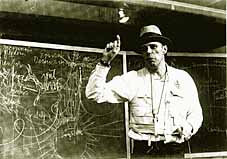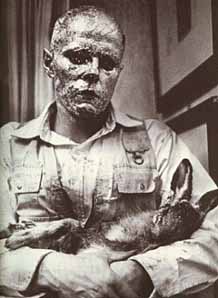 Only
on condition of a radical widening of definition will it be possible for
art and activities related to art to provide evidence that art is now
the only evolutionary-revolutionary power. Only art is capable of dismantling
the repressive effects of a senile social system that continues to totter
along the deathline: to dismantle in order to build A SOCIAL ORGANISM
AS A WORK OF ART.
Only
on condition of a radical widening of definition will it be possible for
art and activities related to art to provide evidence that art is now
the only evolutionary-revolutionary power. Only art is capable of dismantling
the repressive effects of a senile social system that continues to totter
along the deathline: to dismantle in order to build A SOCIAL ORGANISM
AS A WORK OF ART.
This most modern art discipline - Social Sculpture/Social Architecture - will only reach fruition when every living person becomes a creator, a sculptor, or architect of the social organism.
Only then would the insistence on participation of the action art of FLUXUS and Happening be fulfilled; only then would democracy be fully realized. Only a conception of art revolutionized to this degree can turn into a politically productive force, coursing through each person, and shaping history.
But all this, and much that is as yet unexplored, has first to form part of our consciousness: insight is needed into objective connections. We must probe (theory of knowledge) the moment of origin of free individual productive potency (creativity).
We then reach the threshold where the human being experiences himself primarily as a spiritual being, where his supreme achievements (work of art), his active thinking, his active feeling, his active will, and their higher forms, can be apprehended as sculptural generative means, corresponding to the exploded concepts of sculpture divided into its elements - indefinite - movement - definite (see theory of sculpture), and are then recognized as flowing in the direction that is shaping the content of the world right through into the future.
This is the concept of art that carries within itself not only the revolutionizing of the historic bourgeois concept of knowledge (materialism, positivism), but also of religious activity.
EVERY HUMAN BEING IS AN ARTIST who - from his state of freedom - the position of freedom that he experiences at first-hand - learns to determine the other positions in the TOTAL ARTWORK OF THE FUTURE SOCIAL ORDER!
Self-determination and participation in the cultural sphere (freedom): in the structuring of laws (democracy); and in the sphere of economics (socialism). Self-administration and decentralisation (three-fold structure) occurs: FREE DEMOCRATIC SOCIALISM.
THE
FIFTH INTERNATIONAL is born
Communication occurs in reciprocity: it must never be a one-way flow from
the teacher to the taught. The teacher takes equally from the taught.
So oscillates - at all time and everywhere, in any conceivable internal
and external circumstance, between all degrees of ability, in the work
place, institutions, the street, work circles, research groups, schools
- the master/pupil, transmitter/receiver, relationship. The ways of achieving
this are manifold, corresponding to the varying gifts of individuals and
groups.
THE ORGANIZATION FOR DIRECT DEMOCRACY THROUGH REFERENDUM is one such group. It seeks to launch many similar work groups or information centres, and strives towards world-wide cooperation.
Revolutionizing Human Thought
by RoseLee Goldberg
The
German artist Joseph Beuys believed that art should effectively transform people's everyday lives. He too resorted
to dramatic actions and lectures in an attempt to change consciousness.
'We have to revolutionize human thought', he said, 'First of all revolution
takes place within man. When man is really a free, creative being who
can produce something new and original, he can revolutionize time.'
should effectively transform people's everyday lives. He too resorted
to dramatic actions and lectures in an attempt to change consciousness.
'We have to revolutionize human thought', he said, 'First of all revolution
takes place within man. When man is really a free, creative being who
can produce something new and original, he can revolutionize time.'
Beuys's actions often resembled Passion plays with their stark symbolism and complex and systematic iconography. Objects and materials — felt, butter, dead hares, sleighs, shovels — all became metaphorical protagonists in his performances. At the Galerie Schmela in Dusseldort, on 26 November 1965, Beuys, his head covered in honey and gold leaf, took a dead hare in his arms and quietly carried it round the exhibition of his drawings and paintings, 'letting it touch the pictures with its paws'. Then he sat on a stool in a dimly lit corner and proceeded to explain the meaning of the works to the dead animal, 'because I do not really like explaining them to people', and since 'even in death a hare has more sensitivity and instinctive understanding than some men with their stubborn rationality'.
Such meditative conversation with himself was central to Beuys's work. In terms of artists' performances it marked a turning point from earlier Fluxus actions. Yet his meetings with Fluxus had confirmed Beuys's own teaching methods at the Dusseldorf Academy where he had become professor of sculpture in 1961, at the age of 40. There he had encouraged the students to use any material for their work and, more concerned with their humanity than their eventual success in the art world, conducted most of his classes in the form of dialogues with students. In 1963, he organized, at the Academy, a Fluxus Festival with many American Fluxus artists participating. Beuys's polemical art and anti-art attitudes soon began to disturb the authorities; considered a disruptive element within the institution, he was always up against considerable opposition there and was finally, in 1972, dismissed amidst violent student protest.
Beuys's Twenty-four Hours (1965) was also given as part of a Fluxus event which included Bazon Brock, Charlotte Moorman, Nam June Paik, Tomas Schmit and Wolf Vostell. Having fasted tor several days before the opening of the performance at midnight on 5 June, Beuys confined himself to a box for twenty-four hours, stretching out from time to time to collect objects around him, his feet never leaving the box. 'Action' and 'time' - 'elements to be controlled and directed by human will' - were reinforced in this lengthy and meditative concentration on objects.
Eurasia (1966) was Beuys's attempt to examine the political, spiritual and social polarities that characterize existence. Its central motif was 'the division of the cross', which for Beuys symbolized the division of people since Roman times. On a blackboard he drew only the upper section of the emblem, and proceeded, through a series of actions, to 'redirect the historical process'. Two small wooden crosses embedded with stopwatches lay on the floor; nearby was a dead hare transfixed by a series of thin wooden sticks. As the alarmbells of the stopwatches rang, he strewed white powder between the legs of the hare, stuck a thermometer in its mouth and blew in a tube. Then he walked over to a metal plate on the ground, kicking it with force. To Beuys, the crosses represented the division between east and west, Rome and Byzantium; the half cross on the blackboard the separation between Europe and Asia; the hare the messenger between the two; and the plate a metaphor for the arduous and frozen trans-Siberian journey.
 Beuys's
fervour took him to Northern Ireland, Edinburgh, New York, London, Berlin
and Kassel. Coyote: I Like America and America Likes Me was a dramatic
one-week event which began on the journey from Dusseldorf to New York
in May 1974. Beuys arrived at Kennedy Airport wrapped from head to toe
in felt, the material which was for him an insulator, both physically
and metaphorically. Loaded into an ambulance, he was driven to the space
which he would share with a wild coyote for seven days. During that time,
he conversed privately with the animal, only a chainlink fence separating
them from the visitors to the gallery. His daily rituals included a series
of interactions with the coyote, introducing it to objects - felt, walking
stick, gloves, electric torch, and the Wall Street Journal (delivered
daily) — which it pawed and urinated on, as if acknowledging in its
own way the man's presence.
Beuys's
fervour took him to Northern Ireland, Edinburgh, New York, London, Berlin
and Kassel. Coyote: I Like America and America Likes Me was a dramatic
one-week event which began on the journey from Dusseldorf to New York
in May 1974. Beuys arrived at Kennedy Airport wrapped from head to toe
in felt, the material which was for him an insulator, both physically
and metaphorically. Loaded into an ambulance, he was driven to the space
which he would share with a wild coyote for seven days. During that time,
he conversed privately with the animal, only a chainlink fence separating
them from the visitors to the gallery. His daily rituals included a series
of interactions with the coyote, introducing it to objects - felt, walking
stick, gloves, electric torch, and the Wall Street Journal (delivered
daily) — which it pawed and urinated on, as if acknowledging in its
own way the man's presence.
Coyote was an 'American' action in Beuys's terms, the 'coyote complex' reflecting the American Indians' history of persecution as much as 'the whole relationship between the United States and Europe'. 'I wanted to concentrate only on the coyote. I wanted to isolate myself, insulate myself, see nothing of America other than the coyote . . . and exchange roles with it.' According to Beuys, this action also represented a transformation of ideology into the idea of freedom.
To Beuys, this transformation remained a key to his actions. His idea of 'social sculpture', consisting of lengthy discussions with large gatherings of people in various contexts, was a means primarily to extend the definition of art beyond specialist activity. Carried out by artists, 'social sculpture' would mobilize every individual's latent creativity, ultimately moulding the society of the future. The Free University, an international, multi-disciplinary network set up by Beuys in conjunction with artists, economists, psychologists etc., is based on the same premises.
From the book "Performance Art" by RoseLee Goldberg, Thames and Hudson, London, 1988
[Joseph
Beuys (May 12, 1921, Krefield, Germany – January 23, 1986, Dusseldorf,
Germany) was an artist who produced sculpture, performance art, video
art and installations. He is widely regarded as one of the most influential
European artists of the second half of the 20th century. He studied at
the academy in Düsseldorf from 1946 to 1951 and became a professor
there, but was dismissed in 1972 after he insisted that his classes must
be open to anybody who wanted to take them. Beuys was an environmentalist,
involved in politics, and interested in language, animals, and consciousness.
A large retrospective of Beuys' work was held at the Guggenheim Museum
in New York City in 1979.]